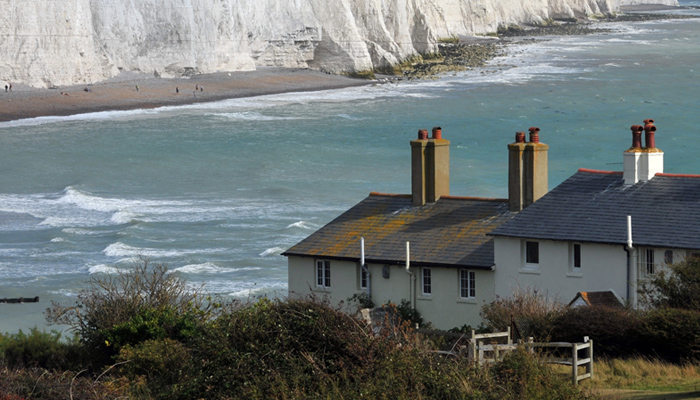Flood Planning and Preparation for Your Home
In recent years, we have experienced dramatic extremes weather wise in the UK. Storms are becoming more regular and more destructive, followed by soaring temperatures and drought in summer. Despite the opposing weather conditions, one thing remained a constant throughout the year: the risk of flooding.
In which season is flooding most likely to occur?
Floods can occur at any time during the year. This can be due to unusually dry periods when the ground hardens and subsequent heavy rains simply run off the surface, or waterlogged ground following a prolonged period of wet weather.
Risk of flooding in winter - Traditionally winter is when we expect to see the highest levels of flooding, with the prevalence of storms and cold temperatures. In the winter of 2022, we saw widespread devastation and disruption as the UK was battered by three closely followed storms which resulted in almost 200 flood warnings being issued across the UK (The Flood People, 2022). Hit with heavy snowfall in some areas in December 2022 many experienced prolonged disruptions due to the freezing conditions followed by the effects of it quickly thawing leaving an excess of ground water. Compounded by further precipitation, just one month into 2023 and several parts of the UK found themselves under water due to the heavy rainfall with over 250 flood warnings issued (Riches, 2023). In winter 2022 Babet caused widespread flooding.
Risk of floods in spring - In spring, we are faced with two potential issues. The first is the when the winter snow melts away in higher altitude areas which have retained snow throughout the winter or if we experience heavy spring rain.
Risk of floods in summer - Flash flooding in the summer is becoming more and more common. In the past 20 years, we have experienced the top 10 hottest years in the UK (Carbon Brief, 2023). The rising temperatures in summer especially, mean that it is now crucial that we learn to adapt to coping with these intense heatwaves. Once upon a time, heatwaves may have been perceived as ideal for those opting for a staycation however with these heatwaves comes uncomfortable conditions and droughts. The ground becomes very dry and if it is followed by heavy rain, flash flooding poses a real threat.
Risks of floods in autumn - If Autumn rains follow a long dry summer the potential for flooding and flash flooding is similar to that of summer. In addition, the build-up of fallen leaves can block drains and allow surface water to build up.
As we can see, now more than ever, it is prudent to invest some time in creating a personal flood plan.
What preventative measures can I put in place to mitigate damage caused by flooding?
The Environment Agency reported in February 2022 that more than 40,000 properties were protected from the damaged caused by Storm Dudley, Eunice and Franklin thanks to the installation of temporary flood defences. Part of your flood plan, a key consideration should be knowing where to go to source sandbags and other defences. For longer-term you may consider investing in airbrick covers, non-return valves for drains and waste pipes, and demountable barriers. Some home insurance plans offer financial support towards flood and storm prevention. Check your policy wording to see if this additional financial support is included.
As well as temporary considerations it is also important to be aware of the long-term risks of ground saturation such as subsidence and landslips, especially where trees and ground shrubs may have been recently removed as the networks of roots will often be preventative in ground movement. Hard-standing areas can also allow for a build-up of water therefore good drainage is essential.
In order to minimise the opportunity for blockages to arise, ensure that your property is maintained well. Clear leaves from drains and gutters, access the drainage system for any blockages or corroding as well as checking walls are in a good state of repair. It is important to be aware that your insurance will not provide cover for loss or damage as a result of poor maintenance or unresolved issues relating to a previous claim.
What should I do to prepare for flooding?
As mentioned, you should invest time in creating a personal flood plan. The government offers a downloadable checklist. Some of the key things include taking the following actions:
- Register for the government’s flood warning service online;
- Source sandbags and temporary flood barriers to help protect around your home;
- Cover all vents, doors, windows and airbricks to limit the amount of water that can soak through;
- Ensure all plugs in sinks and baths are in. Weigh them down with something heavy such as a sandbag;
- If possible, consider raising power sockets and phone cables to a higher point;
- Have an itemised list of key personal property which could be damaged during a flood, and take photographs of your home both internally and externally to assist with any claims and make sure that your home and contents cover is in place;
- Move as much as you can off the ground floor. If you have a second floor or loft then be sure to move any irreplaceable / expensive items to the higher level to avoid damage;
- Prepare an emergency flood kit including a fully charged mobile phone, torch, batteries, medication, water, food, waterproof clothing and wellington boots and store this in an easily accessible dry place;
- Make a plan of the safest and fastest route to evacuate;
- Make a list of emergency contacts such as the local council, your gas and electricity supplier, fire brigade and of course, your insurance provider;
- If still safe to do so, move your car to an area where flooding is less likely.
What should you not do in the event of a flood?
- Do not attempt to walk, swim or drive through floodwater. As little as six inches of fast-flowing water can knock an adult off their feet, you could also be injured by any debris being swept along in the current;
- Do not let children or pets play in the water;
- Never touch electrical sources if you’re in water;
- Don’t forget to wash your hands thoroughly if you come into contact with the flood water – there may be sewage in it;
- Do not forget to check your insurance cover is in place.
Helpful resources to assist your planning
The Government offers a guide on what to do before, during and after a flood which features a checklist on how you can reduce the effects of flooding on you and your property.
Home insurance tailored for you
We offer specialist home insurance policies tailored to your needs. Contact our home insurance team today for a quote on 03447 368 249 or see our home insurance page.
About the author
James Cooper is a respected industry leader with around 10 years' experience in the home and property insurance sector. He works across a broad range of insurance product and policy development and delivery, including product development; customer sales and marketing; and P&L accountability.
Sources:
- Carbon Brief, 2023. Last year was a dramatic one for the UK’s climate. [online] https://www.carbonbrief.org/met-office-a-review-of-the-uks-climate-in-2022/
- The Flood People, 2022. UK Floods: Storms Dudley, Eunice and Franklin. [online] https://www.jbarisk.com/products-services/event-response/uk-floods-storms-dudley-eunice-and-franklin/
- Guardian, 2022. Storm Eunice: at least four dead as worst storm in decades roars in. [online] https://www.theguardian.com/uk-news/2022/feb/18/storm-eunice-record-breaking-gusts-chaos-millions-uk-britain-met-office
- The Environment Agency, 2022. Environment Agency warns of ongoing flood risk following Storm Franklin. [online] https://www.gov.uk/government/news/environment-agency-urges-ongoing-vigilance-as-storm-eunice-continues
Date: December 02, 2024
Category: Home and Property


















